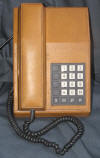
from a 1983 commercial folder
 |
|
Double click on this picture to enlarge it. | ||
|
from a 1983 commercial folder |
The 8100 ATEA telephone was originally designed to be used with a PABX. This phone's styling goes back to the mid 1970s, when ATEA's designer of industrial styling Armand Gerniers came op with the innovative look of the 8000 system phone. The same styling was also used for the "poste nationale" for the local operating company RTT.
I think it was the first phone with a complete electronic circuit. The commercial folder explains the features: a R button, a mute microphone, and switchable between dial pulse or multi frequency signaling to the exchange (typical ATEA's well known flexibility). Later versions had a 10 number store also, unusual in the early 1980s
The keypad of the first versions had some mechanical problems, so a new keypad had to be designed . The basic phone was made of white ABS plastic. In the second half of the 1980s, an executive version was added, the phone was "packaged" in a leather version, giving it an exclusive look.
ATEA became part of Siemens, and after a transition period, the policy was not to compete within Siemens with different products, so ATEA had to quit delivering this phone to his customers, but a big quantity of this phone were still available.
When ATEA celebrated his centennial in 1992, they wanted to give it as a present to their employees, but they had one problem. This phone was designed for use with a PABX, not for use on the public telephone network in Belgium. So Atea had to call the Operating Company Belgacom to inquire. Could ATEA give this PABX phone for use on the public Belgian telephone network? Surprisingly Belgacom replied: "Although your phone does not meet the public telephone network requirements, it's quality is much higher then those junk phones they sell in these days on the consumer market. So go ahead. "
The red phone I got as a present from I do not remember who...
Last changed on 11/03/20 by Jan